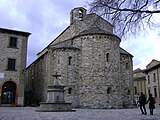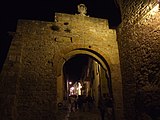San Leo
| San Leo | ||
|---|---|---|

|
|
|
| Country | Italy | |
| region | Emilia-Romagna | |
| province | Rimini (RN) | |
| Coordinates | 43 ° 54 ' N , 12 ° 21' E | |
| height | 589 m slm | |
| surface | 53 km² | |
| Residents | 2,877 (Dec. 31, 2019) | |
| Population density | 54 inhabitants / km² | |
| Post Code | 47865 | |
| prefix | 0541 | |
| ISTAT number | 099025 | |
| Popular name | Leontini | |
| Patron saint | San Leone (August 1st) |
|
| Website | San Leo | |
 City and fortress of San Leo on Mons feretri |
||
San Leo is an Italian commune with 2877 inhabitants (as of December 31, 2019) in the province of Rimini near San Marino and near the Adriatic Sea in the Emilia-Romagna region . The districts of Montefotogno , Pietracuta and Torello are on the Marecchia river . The place was named after Bishop Leo, who came from across the Adriatic and died in 360 (his feast is celebrated on August 1st): He is said to have preached Christianity here. The lid of his stone sarcophagus is now in the cathedral.
The municipality is a member of the association I borghi più belli d'Italia (The Most Beautiful Places in Italy).
history
After various changes of ownership during the war between the Eastern Roman troops under Belisarius and Narses and the Ostrogoths between 536 and 553, San Leo came under the rule of the Lombards after 568 , and the ancient name of the mountain gradually became the name of the entire surrounding landscape, the Montefeltro . The first secure bishop was called Agathus and took part in a bishops' meeting in Rome in 826; today San Leo belongs to the diocese of San Marino-Montefeltro . The Lombard Duke Orso resided here since 885 and sponsored the church, for example through the foundation of a stone canopy on four columns above the main altar of the parish church, where his name can be read.
In the dispute between the German King Otto I and his rival Berengar II from Piedmont, who had his court here between 962 and 963, Otto besieged him and forced him to give up; then Berengar was taken prisoner to Bamberg, where he died.
In 1155, Montefeltrano I (approx. 1135 - 1202) is the first member of the important noble family of Montefeltro in San Leo. In 1226, Emperor Friedrich II gave two of his descendants the county of Urbino , which included the town and its surrounding area.
As early as 1213, St. Francis stayed in San Leo as a guest of Counts Buonconte and Taddeo. After lengthy battles between the Montefeltro and the Malatesta of Rimini , the town was again owned by the original lords in 1441. The House of Montefeltro rose to become dukes of Urbino in 1443 . With the extinction of Montefeltro in 1508, the duchy was inherited by the della Rovere family , the relatives of Pope Julius II (1503-1513). The Duchy of Urbino, which had existed since 1472, finally fell to the Papal States after the family died out in 1631. On September 24, 1860, San Leo was captured by the Italian troops and has been part of the Italian state ever since.
Until August 15, 2009, San Leo belonged to the province of Pesaro and Urbino in the Marche region . By decision of a referendum that took place on December 17 and 18, 2006, the place changed provincial affiliation with six other municipalities and has since been part of the province of Rimini . The brands filed an objection to the Italian Constitutional Court, which was rejected as unfounded.
Attractions
The most important sacred buildings are the parish church "Pieve di Santa Maria Assunta" from the 9th century, also known as the basilica , and the somewhat elevated, larger Cathedral of San Leone from the 12th century. Both churches can be reached after a city gate and the main square, the Piazza Dante, with three palaces, including the Palazzo Medici. The rear facade of the Pieve, which is defined by three apses, is determined by pilaster strips and blind arches , which also characterize the long side. In the three-aisled interior is the altar with its canopy; There is also a small shrine supposedly donated by St. Leo. The high Romanesque cathedral, begun in 1173, consists of gold-colored sandstone and not only has a rear front with three apses, but also a three-part main facade with narrow half-columns and blind arches; like the parish church, the three-aisled, handsome interior has a crypt with three apses. The bell tower stands individually on a slight hill.
San Leo fortress
The impressive fortress above San Leo is visible from afar at an altitude of 600 meters. It has an approximately triangular floor plan with a two-winged building complex on the steep slope of the city mountain, which was called Mons Feretrius in Roman times ; the opposite side is protected by two mighty round towers from the Renaissance. In Roman times a temple for the god Iuppiter Feretrius is said to have stood on the rocky hilltop of San Leo . The expansion into the originally square fortress (part of the castle complex on the mountain slope fell into the abyss) was undertaken in the late 15th century by the architect Francesco di Giorgio Martini from Siena at the will of the Duke of Urbino, Federico von Montefeltro , and thus created a practically impregnable one Fortress .
From the 18th century the fortress of San Leo served as a dungeon for the Vatican . From 1791 to 1795 the most famous prisoner was the alchemist , physician and Freemason Giuseppe Balsamo, better known under the name Count Alessandro Cagliostro invented himself , who spent four years of excruciating imprisonment after being sentenced to death by the Holy Inquisition for heresy and his punishment from Pope Pius VI. (1775–1799) had been commuted to life imprisonment. He died on August 26, 1795 in a narrow dungeon of the fortress called "pozzetto" ( Italian well ). Today it is a museum: You can visit old furniture and weapons (from the Middle Ages to the Second World War), a torture cellar with the relevant torture tools and the cell in which the alleged Count Cagliostro was imprisoned until his death. The impostor and alchemist probably died of syphilis ; an assassination attempt by his guards is unlikely.
The pride of the residents of San Leo in their place and the fortress is manifest in the motto formulated in their dialect: Un sol Pépa, un sol Dé, un sol fort d 'San Lé (Only one Pope, only one God, only one Fortress of San Leo).
Twin cities
Web links
Individual evidence
- ↑ Statistiche demografiche ISTAT. Monthly population statistics of the Istituto Nazionale di Statistica , as of December 31 of 2019.
- ^ I borghi più belli d'Italia. Borghipiubelliditalia.it, accessed August 6, 2017 (Italian).
- ↑ Il Resto del Carlino, La Valmarecchia rimane in Romagna (Italian)
- ↑ Touring Club Italiano (ed.), Guide Rosse: Marche, Milan 1979, p. 211










